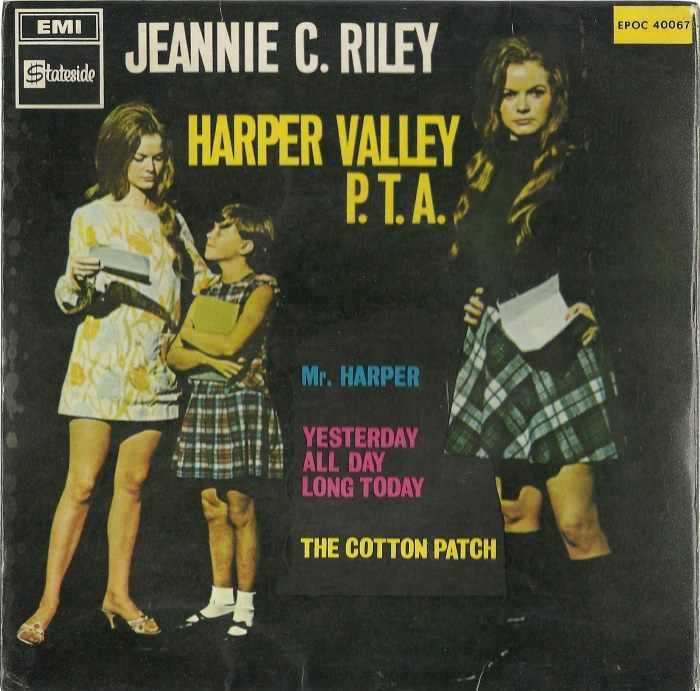September 21, 1968
- STAYED AT #1:1 Week
In The Number Ones, I'm reviewing every single #1 single in the history of the Billboard Hot 100, starting with the chart's beginning, in 1958, and working my way up into the present.
We tend to think that art happens one way: A tortured genius, sitting alone somewhere, finds new ways to challenge and provoke and comment on the historical moment. Sometimes, it does work that way. Just as often, though, art is motivated by accident and happenstance and (especially) money. Sometimes, the best art -- the stuff that resonates down through the generations -- started out life as a quick-buck scheme. That's the case with "Harper Valley P.T.A.," which was both a goofy Nashville country one-off novelty and a resounding feminist anthem. Great song, too.
https://youtube.com/watch?v=Yg3-7leOkOg&list=PLrpyDacBCh7AlsrT3LMFWrjNvSzKBd3-P
In the '70s, "Harper Valley P.T.A." songwriter Tom T. Hall would become a country star and develop a reputation as a master storyteller. But when he wrote "Harper Valley P.T.A.," Hall was a journeyman radio announcer, moving around the Southeast and working for different small-town country stations. At that point, songwriting was really more of a hobby for him than anything.
Hall wrote "Harper Valley P.T.A." after Margie Singleton asked him to write her a song that would be similar to "Ode To Billie Joe," the Bobbie Gentry song that had been a huge hit the previous year. Hall drew on the Sinclair Lewis novels he'd been reading and on his own memories of a single mother who, 20 years earlier in his Kentucky hometown, had taken the local authorities to task for hypocrisy.
And "Harper Valley P.T.A." really is a masterfully told story. A local widow's daughter takes a note home to her from school. The town's P.T.A. heads have noticed that the widow is wearing short skirts and hanging out with men (and "running wild"), and they don't think that's any way for a mother to act. So at the next meeting, she bursts into the room wearing a miniskirt and denouncing these upright citizens for all the shady shit that they've been doing. It's virtually impossible to hear a song like that and not side with the widow. And Hall saves the big reveal for the end of the song: The narrator is the widow's daughter. She's telling the story because her mother has done something amazing.
Like "Ode To Billie Joe," "Harper Valley P.T.A." is a finely observed story about small-town life, and about the ways in which people can be unthinking assholes to one another. But "Ode To Billie Joe" is a song about buried feelings, about things left unsaid. "Harper Valley P.T.A." is the opposite. It's a triumphantly outspoken explosion, a sneering dismissal of those forces. It sounds tough now, so it must've been revolutionary in 1968, when all sorts of social conventions were up in the air and all sorts of people were doing what they could to bring them back down.
Margie Singleton did record a version of "Harper Valley P.T.A.," but her slight and mannered take on the song went nowhere. But Shelby Singleton heard something in it. Shelby -- no relation to Margie -- was a pure record-business huckster. Six years earlier, working for Mercury, he'd helped push Paul & Paula's "Hey Paula" to #1. Later on, he bought Sun Records from Sam Phillips and spent years reissuing its catalog recordings in different priced-to-move packages. He sold novelty songs. He sold white supremacist songs. After Elvis Presley died, he put an Elvis impersonator in a mask, called him Orion, and pushed the unspoken narrative that Elvis had faked his death and that this was really him.
Point is: Shelby Singleton did not particularly care about art. And yet in marketing "Harper Valley P.T.A.," he helped turn that song into art. Singleton wanted to find a singer who could sell the song the right way -- someone sexy, basically. Jeannie C. Riley, from Texas, had moved to Nashville after someone had told her that she could probably make a living singing. She'd packed up her daughter and her husband, but she was going nowhere, recording demos while working as a secretary at a record company. But Singleton heard one of those demos, saw how she looked, and brought her in to record "Harper Valley P.T.A." (I'm really only scratching the surface of the song's history here. Tyler Mahan Coe recorded three episodes of his great country-history podcast Cocaine & Rhinestones about "Harper Valley P.T.A.," and I can't recommend that show strongly enough.)
The song and Riley were made for each other. In her vocal, Riley puts a snarl in her voice, but she's enjoying it, too. She plays the widow as a force of nature -- someone who is finding a sort of battlefield ecstasy in finally putting all these patriarchal shitheads on blast. Riley latches down on every word, selling the hell out of the song. And as a storyteller, she brings a you-won't-believe-what-happened-next breathlessness. The song's twangy guitar dances around her voice, urging her on. It's perfect little three-minute radio play, everyone involved playing their parts perfectly.
In the years that followed, Riley would essentially play the widow's character, wearing the miniskirts and boots that were new to Nashville at the time. She had a few minor country hits, but nothing crossed over. Eventually, she became a fundamentalist Christian and distanced herself from the song, though she eventually relented and began singing it again. She only caught the zeitgeist that one time. But that one time, she made art out of it, whether she meant to or not.
GRADE: 10/10
BONUS BEATS: In 1978, someone made a Harper Valley P.T.A. movie, with the former I Dream Of Jeannie star Barbara Eden as the widow. Eden also played the widow on a Harper Valley P.T.A. TV show, which ran for two seasons on NBC, starting in 1981. Here's a TV ad for the movie:
https://youtube.com/watch?v=N30ASJgb19Q
BONUS BONUS BEATS: In 1984, Jeannie C. Riley got Tom T. Hall to write her a sequel song called "Return To Harper Valley." In this one, the widow, her dress now "well below her knees." goes back to the school and sees that the real problem is sex and drugs, so she goes to tell the P.T.A. all about it, effectively becoming one of the scolds from the original song. The sequel was terrible, and it bricked. Here it is:






